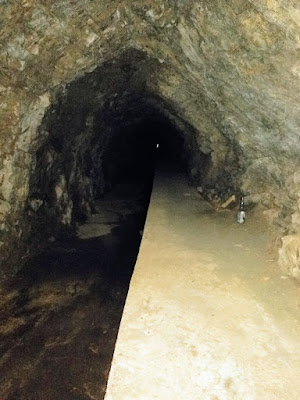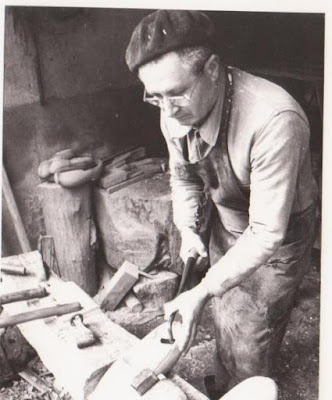A Radio Sevilla report and interview with Antonio, a volunteer at the Banco de Alimentos en la Operación Buena Gente (the Foodbank of Seville, in 2017).
Friday, April 30, 2021
Thursday, April 29, 2021
Chasseurs Alpins in Terror Aftermath
On the evening of 14
July 2016, a 19-tonne cargo truck was deliberately driven into crowds of people
celebrating Bastille Day on the Promenade des Anglais in Nice, France,
resulting in the deaths of 86 people and the injury of 458 others.
The Islamic State claimed responsibility for the attack, saying Lahouaiej-Bouhlel answered its "calls to target citizens of coalition nations that fight the Islamic State". On 15 July, François Molins, the prosecutor for the Public Ministry, which is overseeing the investigation, said the attack bore the hallmarks of jihadist terrorism.
Chasseurs Alpins were tasked to patrol the streets of Nice.
Wednesday, April 28, 2021
Milthon Duarte
From an early age, Guatamala born Milthon Duarte felt a curiosity for art and science. Drawing and painting were the starting point before investigating other techniques and languages such as: wood engraving, sculpture, graphic design, scenography, muralism and audiovisual creations, among others.
Within his career he has also participated in different individual and group exhibitions in Central America and Europe.

Milthon Duarte is currently developing artistic projects and teaches drawing and painting classes in his own workshop located in the centre of Pamplona.
Tuesday, April 27, 2021
Freedom Fighters
The short film interweaves the stories of Tabassum Adnan,
Saima Sharif and Syeda Ghulam Fatima. Sharif is the only woman in her village
to have joined the police force. In the wake of the death of her brother, who
also was a police officer, she joins the Elite Force, an antiterrorism unit
that assists the police. Fatima works to eradicate bonded labor and child
labor, especially within the brick kiln industry. She has helped to free an
estimated 80,000 people from slavery.
Monday, April 26, 2021
Gente de Boina
'Gente de Boina' is a 1971 documentary made by Televisión Española, which captured the idiosyncrasy of the people of Tomelloso (La Mancha). In addition, its script was written by the great Tomellosero Francisco García Pavón, father of the Spanish crime novel.
The characteristic blue berets and blouses told the story of the working people. Today, several Tomelloseros have wanted to pay tribute to those beret wearing people with a mural in one of the most central streets of the city, the Don Víctor Peñasco street.
Artist, Tomás Gutiérrez: "I wanted to pay tribute to the lost trades of yesteryear, our grandparents and this complicated situation [Covid epidemic]".
Some Tomelloseros, with berets, approach the artist to ask and tell and congratulate him. "The first thing they have explained to me has been who appears in the mural, the nicknames, and also how they helped with the work at the time and their longing for the past."
Sunday, April 25, 2021
The French Angel - Maurice Tillet
Maurice Tillet was born in 1903 in the Ural Mountains in Russia to French parents.
As a child, Maurice had a completely normal appearance and Tillet was nicknamed "The Angel" due to his angelic face. In 1917, Tillet and his mother left Russia due to the Revolution and moved to France, where they settled in Reims.
When Tillet was 20, he noticed swelling in his feet, hands, and head, and after visiting a doctor was diagnosed with acromegaly—a condition usually caused by a benign tumour on the pituitary gland, resulting in bone overgrowth and thickening.

He had wanted to become a lawyer, but his acromegaly prevented him from doing so. Tillet served in the French Navy for five years as an engineer.
In February 1937, Tillet met Karl Pojello (Lithuanian Karolis Požėla) in Singapore. Pojello was a professional wrestler, and convinced Tillet to enter the business. Tillet and Pojello moved to Paris for training, and Tillet wrestled for two years in France and England until World War II forced them to leave for the United States in 1939.
In Boston, in 1940, promoter Paul Bowser pushed Tillet as a main eventer, and he became a large draw in the area. As a result of his popularity, Tillet was booked as unstoppable, and was unbeaten for a span of 19 consecutive months. Tillet was the AWA World Heavyweight Champion from May 1940 until May 1942.
Tillet died on September 4, 1954, in Chicago, from cardiovascular disease after hearing of his trainer's passing.
Saturday, April 24, 2021
Laëtitia Guilbaud
Laëtitia Guilbaud was born in France in 1980. Her work is all about women. She is inspired by fashion and Pin-up art, this is why she depicts women with plenty of character and femininity. From an early dark abstract and provocative start, Laetitia's paintings have evolved into a more colorful image of modern women.
In 2001, after an art degree in Rennes, she decided to paint them with acrylic on canvas. She started to exhibit in bars, restaurant and art fairs.
 |
| Vin Rouge |
She has lived in Scotland from 2006 to 2016 where she became a full time artist in 2008. She has had several articles written in relation to her work, especially regarding celebrity portraits.
Laetitia has exhibited her work in galleries across Britain. She has also had exhibitions in France, Belgium and Italy too. Her work is often shown in charity events.
Laetitia came back to live in France in 2016. She works in an art studio called "Les Ateliers du Pressoir" in La Chaize-Giraud (Vendée).
Friday, April 23, 2021
Abandoned New Zealand
Faithful followers of this blog know about my love of abandoned "stuff"; houses (villages), factories, bunkers, shipwrecks, railways... Anything old!
It is the one thing I really miss, living in New Zealand. Of all countries in the "New World", NZ has little to offer in that respect, apart from some old bunkers, a shipwreck here and there and, when really lucky, an abandoned industrial site.
However, on my daily walk with my faithful friend Millie in Trellissick Park the other day, around the corner from where I live and one of the most beautiful nature reserves I know off, I found this old abandoned waterworks with an open entrance door!
It may not look like much, but for me this was real treasure. Outside a long forgotten weir and fish ladder, inside the mountain a long tunnel that at some stage must have carried water from the hills to downtown Wellington.
The heavy steel door looked locked, but wasn't.
Millie was less keen than me to enter the tunnel, at the end covered by another steel gate that was locked, but I sure had my fun for the day.
My green Grof Beret did a great job forming a nice barrier between my head and the weta's living on the ceiling of the tunnel.
Thursday, April 22, 2021
Dieter Meier
Born in Zurich, Switzerland in 1945, the conceptual artist and musician Dieter Meier has lived many lives: poker player, lyricist, musician, novelist, golfer, industrialist, film director, artist, clothing designer, actor, restaurateur, winemaker, vintner, cattle breeder, and Argentine gaucho.
After studying (and dropping out of) Law in the 1960’s, with luck and skill Meier gambled his way into a different life path and became a professional poker player. Thanks to his father, who rose from poor origin to become a successful private banker, Meier was already a millionaire.
Shortly after, in the late 70’s, he found another one of his callings, music. It wasn’t long until he took the music industry by storm, alongside band member Boris Blank, with his group Yello and their hit single “Oh Yeah,” in which Meier provided almost all vocals and lyrics.
After years of directing, acting, and performing worldwide, Meier found himself with a new passion in Argentina: organic agriculture. Soon, he’d begin to produce organic wine, beef, and natural products. In the late 1990s, he bought the 19th century Ojo de Agua ranch, and 2,200 hectares of land in the countryside outside of Buenos Aires, and later acquired vineyards in Mendoza, Patagonia, and Salta.
Wednesday, April 21, 2021
Mr. Jean Beroud's Clogs
At the end
of the 2nd World War, Mr. Jean Beroud left his native village for a
youth work camp in the Jura.
One day of idleness, he carved a small clog from a piece of wood. Noticed by his leaders, this achievement led him directly to the village clog maker who introduced him to his future profession.
Just after the War, he quickly became part of the wood workers created by the youth camps to make clogs for popular relief. Back in Montmerle sur Saone (Ain) he bought a former clog maker workshop to exercise this profession.
Later he would buy second-hand machines; these were sold in 1994 not to a scrap dealer but to Bressan clog makers in Lescheroux (Ain), where they still work.
The carved clogs, the tools and even the posters extolling the wearing of the clog are of course part of the family heritage. Mr. Jean Beroud passed away in 2008, he was one of the last traditional clog makers of the Val de Saone.
Tuesday, April 20, 2021
Vive Le Tour 1962.
Vive Le Tour 1962.
A historical piece of pedals and pain by Louis Malle (1932-1995), with English subtitles. A most entertaining and at times comical film. And yes, many berets too!
Thanks Paul
Monday, April 19, 2021
Benoît Serres
The Aubrac beret, an accent to cut with a knife (“Laguiole”, of course!), Benoît Serres is happy in his native land of Prades-d'Aubrac. In 2014, he had the opportunity to settle away from his family in his village, as at that time, the parental farm did not allow to support him.
His happiness is ominent, with the background of the Aubrac plateau; “everything pleases me…”.
Sunday, April 18, 2021
Paul Rochet - Sourdough Baker
The beret, the moustache, the sweater smeared with flour, the thick hands and build that speak of labour. There is no doubt that Paul Rochet, 63 years old, is part of his land.
Son of a farmer, former mechanic at the Picon cheese dairy in Saint-Félix, this man found a vehicle that was both simple and formidable to give “ meaning " to his existence: bread.
In the bakery installed in his garage in Viuz-la-Chiésaz,
Paul Rochet has been shaping and selling his own organic bread for fifteen
years. A work of craftsman very far from industrial methods, and a know-how of
which he hopes to pass on the keys soon, at the time of retirement.
It’s not just any bread. Hand-kneaded, with organic flour
and homemade natural sourdough, which he has been “feeding” continuously since
1995: a rare species in a field where industrial yeast, with faster effects, is
king.
















































